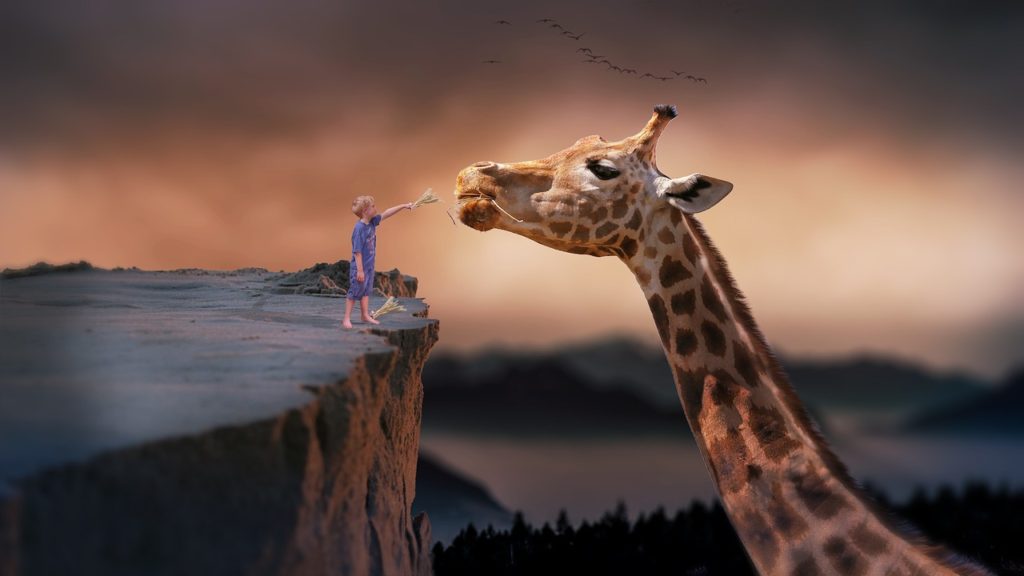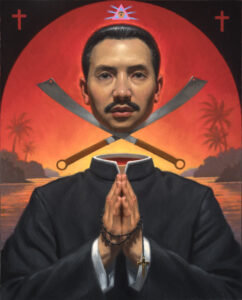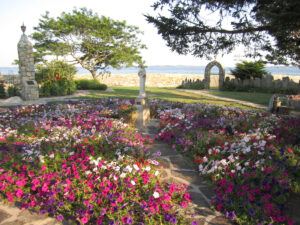The first time I saw Donal Mac Manus address a young Catholic crowd, he was holding court in a Manhattan bar on the topic “Taking Beauty Seriously.” In an upstairs room bedecked with British kitsch, the Irish sculptor shared the enormous sense of responsibility he feels working on a piece of sacred art. Mac Manus wants his work to be spiritually nourishing for people for centuries to come. On one project, an altarpiece, he would pray for half an hour before and after working on the piece. “It felt like I was praying the work into existence,” he told us.
The second time I heard Mac Manus address a group of young Catholics, in a church basement aglow with fairy lights, fellowship, and fajitas, he told us about the time a giraffe lifted him off the ground with its tongue.
Donal Mac Manus (who goes by Dony) is a gifted raconteur. Sit down with him for long enough and you’ll hear him discuss, in his Dublin lilt, how he thinks art can contribute to a culture of life and how contemporary artists need to learn to draw. “For me, drawing is contemplation. It’s listening with your eyes,” he told me.
I interviewed him in a New York rectory on the morning before he caught a flight back to Dublin. He was wearing a black zip-up sweater with a Precious Feet lapel pin. He emphasized to me his love for the craft of art. All artists, he thinks, need the discipline of craft to infuse their work, even their abstract work, with reality. He switched to studying silversmithing after he was kicked out of his university sculpture program. Why was he kicked out? “Because I insisted on beauty, and in art schools today, beauty is a bad word,” he chuckled. More on that in a moment.
Though he’ll happily point to the ways his work grows out of Catholic teaching and practice (a sculpture inspired by the papal encyclical Humanae vitae is a favorite of his), Mac Manus sees himself not as a “Catholic artist” but as an artist who is Catholic. “The primary vocation of the artist is to be an artist, and to be the very best artist he can be. And then your Catholicism will naturally overflow from your interior life into your artwork,” he told me. “You’re not illustrating the faith, but you have a natural artistic overflow of your faith into your art. Which is much more compelling and much more transformational for the artist themselves and the audience.”

As for that giraffe? Believe it or not, the story provides a window in Dony’s formation as an artist. In the early 1990s, Mac Manus attended a sculpture program at the National College of Art and Design in Dublin, where he clashed with the dominant philosophy of the art establishment. Deconstructionists made a statement by pushing plaster sculpture casts out of a third floor window. Mac Manus was horrified.
“It took five seconds for them to land on the ground and crash into tiny pieces—it took me five years to reconstruct that understanding,” he said.
Looking back, Mac Manus sees this act of aesthetic vandalism as a symbol of a broader evil: “We’re in a very destructive period in Western culture. We’re in free fall, culturally. All I’m trying to do, essentially, is at least slow down that free fall, if not turn it around.”
Seeking an escape from the oppressive environment of art school, Dony started wandering the Dublin highways and byways, looking for things to draw from life. He spent a week drawing in the Dublin zoo: He angered a silverback gorilla and had his sketch pad stolen by a chimpanzee. Most fatefully, he tried to feed a giraffe.
Dony held up some hay and the giraffe leaned out of its enclosure and wrapped its tongue around not only the food but all the way down Mac Manus’s arm. The giraffe lifted the petrified Mac Manus three feet off the ground (“I was a skinny art student at the time,” he explains) and then dropped him in a painful, undignified heap with a dislocated shoulder.
A metaphor for Mac Manus’ art career? It is certainly true that Dony’s life and work are characterized by startling confrontations with embodied reality. Perhaps it’s no surprise he cites John Paul II’s teaching on Theology of Body as a major inspiration.
Donal Mac Manus left the sculpture program in Dublin to study silversmithing, re-approaching art by way of artisanship. An early commission got him publicity: A Virgin and Child he sculpted for a drug rehabilitation center, where Our Lady’s feet are crushing a bottle and a syringe, the serpents that ensnare addicts. He got a scholarship in 1999 to study figurative art at the New York Academy of Art. His thesis project was a crucifix with a skinless corpus, making visible the bones and muscles of Christ to drive home how radical the doctrine of the enfleshment of God really is.

Around graduation, Mac Manus was rocked both by 9/11 and the more personal tragedy of losing multiple friends and acquaintances to suicide. He found himself working on a piece in Rome, and while there he was compelled by a mysterious inner prompting to spend three weeks drawing Michelangelo’s Pieta from various angles.
For Mac Manus, these Pieta drawings were “an opportunity to contemplate Christ’s suffering and the Virgin’s suffering, and to be transformed by a deep immersion in this great work.” Michelangelo’s statue healed Mac Manus’ shaken faith in humanity and strengthened his faith in God.
He observed, during these weeks, he was not the only one so affected by the Pieta: People who came to St. Peter’s as tourists paused in front of the statue with tears in their eyes, transformed into pilgrims. Beauty has the power to pierce the heart, and bring with it truth and goodness.
In the next period of his career, Mac Manus focused on teaching rising artists, founding an Irish Academy of Figurative Art and a Sacred Art School in Florence (and working with artists in America as well). A centerpiece of his teaching technique is combining classical nude figure drawing with seminar discussion of Theology of the Body.
Mac Manus say he meets aspiring artists who have “learned everything about the body except what it means.” Mac Manus reminisces about being up till 3 am in SoHo bars, debating Christopher West’s commentaries with friends and students. He proudly recounts how, in Florence, he saw about a dozen of his students baptized in the Duomo. He had sparked their interest in the faith with Theology of the Body seminars—and became a godfather to several of them.
By engaging with the human body in a theological (and specifically Christological) dimension, Mac Manus hopes his art and teaching can redeem the body and sexuality from a pornified culture. “The world needs beauty,” he says. “It’s screaming out for it. And the only thing that’s being offered is the false beauty of pornography.”
Mac Manus is looking for institutional partners to create an art school in the United States. He has found it frustratingly hard to pitch conservative Catholic colleges on his program of nude life drawing classes paired with Theology of the Body seminars. Some of these schools are skittish about nude life drawing on campus. But, Mac Manus says, in order to “detox” the culture from porn, he needs to challenge students “to see the body as an icon of love, and a temple of the Holy Spirit—to develop a purity of vision.”
It’s a project he frames as healing the porn-inflicted wounds on the imagination of artists and audience alike.
Readers can find Mac Manus’s art in many U.S. cities. A sculpture of St. Joseph and the Child Jesus is displayed in Washington D.C.’s Catholic Information Center. In New York, he has a bust of Benedict XVI in St. Patrick’s Cathedral and a statue of St. Josemaria Escriva at the Murray Hill headquarters of Opus Dei.

Reflecting on his thesis project, the crucifix that unveils the “anatomy of God,” Mac Manus explains why he sees beauty in the death of Christ. “The Crucifixion is the ultimate icon of humanity. It’s deicide, which is the most horrific crime, but at the same it actually symbolizes the fullness of the human gift: to give yourself for others.”
Alexi Sargeant is a writer living in New York and the New York Editor of Catholic Arts Today.
Learn more about Dony Mac Manus (or contact him) through his website: http://www.donymacmanus.com/




